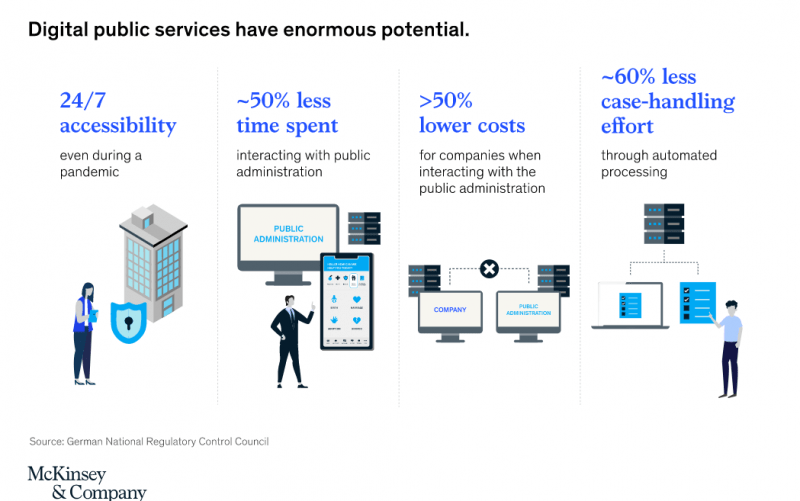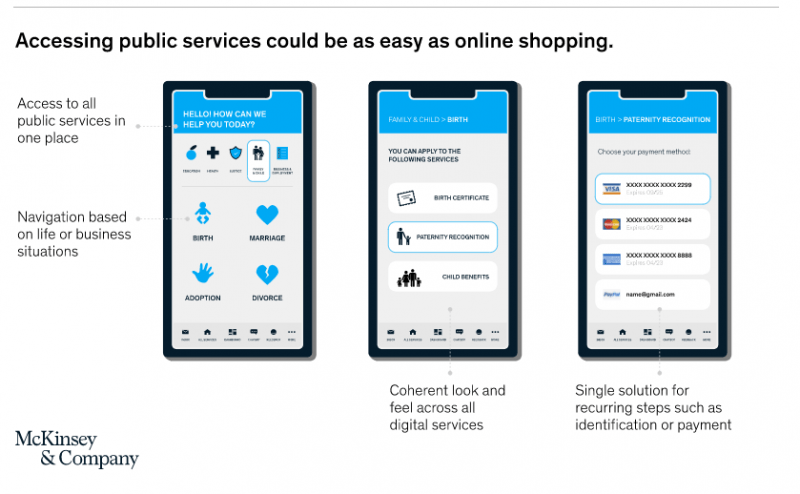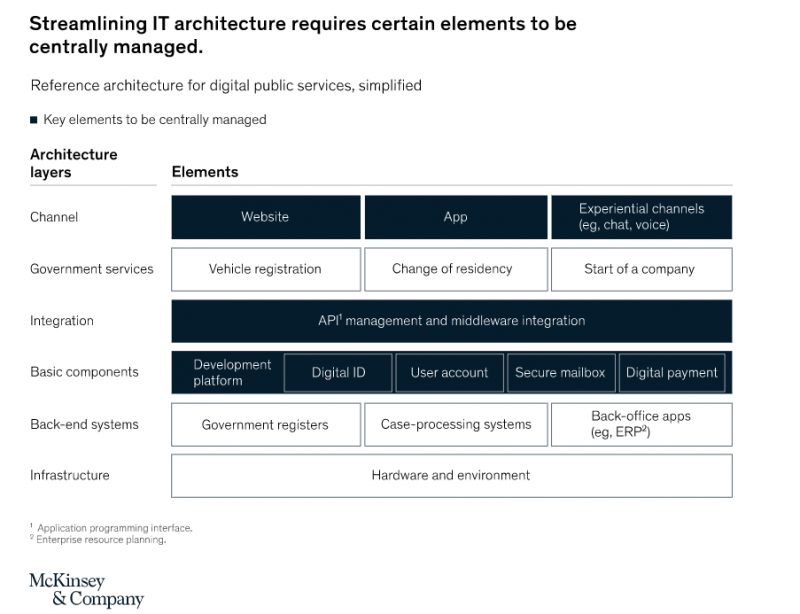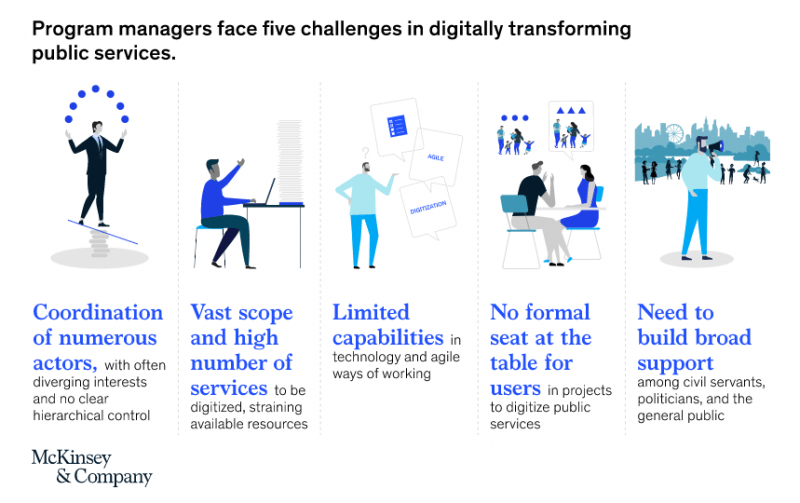Digitizing services helps governments meet public expectations and become more efficient and resilient. The task is complex, but a tried-and-true formula can help them move faster and with limited resources
Article By Matthias Daub, Axel Domeyer, Abdulkader Lamaa, and Frauke Renz from McKinsey & Company

Matthias Daub 
Axel Domeyer 
Abdulkader Lamaa 
Frauke Renz
Destaque feito pelo secretário Nacional de Governo Digital Brasileiro, Luis Felipe Monteiro em seu perfil do linkedin.

“Para muitas pessoas, é uma questão de confiança: os cidadãos que estão satisfeitos com um serviço público têm nove vezes mais probabilidade de confiar no governo do que aqueles que não estão.
Cada vez mais as pessoas não veem por que os serviços públicos devem ser mais complicados do que as compras online. Eles querem ser capazes de encontrar rapidamente os serviços mais relevantes. Eles querem informações em uma linguagem clara e simples e esperam concluir todas as transações por meio de canais digitais – de preferência, por meio de uma única jornada digital.
Implementar essa visão é uma tarefa difícil. Organizações do setor privado geralmente gerenciam apenas algumas jornadas de clientes. Os governos, por outro lado, são responsáveis por 50 a 100 jornadas, que respondem por milhares de serviços individuais
O esforço contínuo para digitalizar serviços públicos na Alemanha ilustra este ponto: o governo agrupou 5.900 transações em 575 serviços distintos na perspectiva do usuário, que, por sua vez, contribuem para 55 jornadas do usuário.”
Ver Post do Secretário Luis Felipe Monteiro no LinkedIn.
Digital public services are an imperative. The private sector has raised the bar on the customer experience, and people expect governments to keep up. For many people, it is a matter of trust: residents who are satisfied with a public service are nine times more likely to trust the government overall than those who are not.
Other benefits are more tangible (Exhibit 1). Unlike physical offices, digital ones are open to the public 24/7—and stay open during public-health crises such as the COVID-19 pandemic. Digital interactions are less time consuming for people and reduce the administrative burden on companies, which can help support business as economies recover from the effects of COVID-19.
Moreover, automating case handling significantly boosts productivity, reducing backlogs and freeing up resources for other priorities—another advantage in the wake of COVID-19, when speed and resilience for delivering critical services (such as unemployment or medical benefits) are paramount.
Public-sector employees also stand to benefit from digitization; fewer repetitive tasks and happier residents pave the way to higher levels of job satisfaction.

Digitization is a whole-of-government challenge
Navigating public services can be bewildering. Information about how to access services is often presented in hard-to-understand bureaucratic language, and users must visit different websites or offices for each service.
Applications routinely require hard copies of supporting documents to still be printed and signed, and many online forms are just as complicated to complete as the paper versions.
Furthermore, the user experience tends to vary across government websites, and users often require multiple accounts and digital IDs to manage their needs.
All of this stands in stark contrast to expectations. More and more often, people see no reason why public services should be more complicated than shopping online. They want to be able to quickly find the most relevant services.
They want information in clear and simple language and expect to complete all transactions via digital channels—ideally, through a single digital journey.
For example, new parents could get a birth certificate, apply for child benefits, register for parental leave, and access other relevant services through one easy process instead of interacting with multiple agencies, often in-person, and sharing the same information multiple times.
Governments can provide a seamless user experience by consolidating digital channels. Instead of visiting multiple websites or apps, people could navigate and access information and services based on life or business situations in one place (which also makes web searches easier).
Using the same solution for recurring service transactions, such as identification or payment, helps users become familiar with the process and promotes broad adoption of the required devices or apps. Moreover, a coherent look and feel across the public services landscape can increase trust in the government’s digital brand.

Implementing this vision is a tall order. Private-sector organizations typically manage just a few customer journeys. Governments, by contrast, are responsible for 50 to 100 journeys, which account for thousands of individual services.
The ongoing effort to digitize public services in Germany illustrates this point: the government has grouped 5,900 transactions into 575 distinct services from a user perspective, which, in turn, contribute to 55 user journeys.
Government services are owned by different departments, agencies, and geographic units, all of which have strong legal independence. Many individual units have started on their own digitization programs and have expended considerable resources to do so. It is no easy task to motivate these actors to contribute to integrated journeys and provide their services via a common digital channel.
A further challenge is the working culture of government. Civil servants are trained to adhere to formal legal procedures, which are designed to promote fairness and equality.
However, that mindset is less helpful when it comes to creating digital products, which requires more informal collaboration within and across public authorities. And since workers with advanced digital skills often choose the private sector over the government, recruiting new talent can be difficult.
Despite these obstacles, a small group of countries has shown that it is possible to rethink public services, and increasing numbers of governments are following their lead. The key to success is a coordinated, whole-of-government approach.
A tried-and-true formula for successful government digitization
Given the challenges, it can take many years to fully digitize public services. However, governments can mitigate complexity if they break implementation down into small steps. Ideally, these will start with quick wins to generate momentum.
To secure such wins, governments can begin by focusing on the digital front end. Offering services online and simplifying forms (while providing guidance on how to complete them) can provide a significant boost to user satisfaction.
Moreover, implementing these changes is relatively speedy and inexpensive. Automation of the back end, on the other hand, requires more time and resources and is thus better suited to a long-term plan.
Amid COVID-19, taking decisive action becomes an imperative. Against the backdrop of high demand for unemployment and other benefits, governments need to ensure speedy and efficient processes and compressed delivery timelines—particularly to alleviate backlogs that have built up during the pandemic.
The resident experience will be improved and, most importantly, people and employees will be able to more easily maintain the physical distance that is so important to controlling the virus.
Governments must do three things well to get services online fast and build engines for continued and sustainable change. First, they must reimagine service journeys, together with the relevant public authorities and users (agile labs).
In parallel, they should enable rapid deployment and simplify integration with back-end systems (scalable IT architecture). Finally, they should empower a central coordination unit to bring together public authorities, shape incentives to reward outcomes for users, and drive communication (smart program management).
‘Agile labs’ to manage stakeholder complexity
For most public services, digital reimagination can significantly enhance the user experience. Forms, for example, can require less data and pull information directly from government databases. Texts or push notifications can use simpler language.
Users can upload documents as scans. In addition, agencies can link touchpoints within a single user journey and offer digital status notifications. Implementing all of these changes is no trivial matter and requires numerous actors to collaborate. Several public authorities are usually involved, each of which owns different touchpoints on the user journey.
The number of actors increases exponentially when local governments are responsible for service delivery. Often, legal frameworks must be amended to permit digitization, meaning that the relevant regulator needs to be involved.
Yet when governments use established waterfall approaches to project management (in which each step depends on the results of the previous step), digitization can take a long time and the results often fall short. In many cases, long and expensive projects have delivered solutions that users have failed to adopt.
The best approach to achieving stakeholder alignment is convening “labs,” each responsible for a specific journey. In this way of working, civil servants from all relevant public authorities collaborate directly with users to reimagine the experience and plan a phased release—from minimal viable product to fully automated service transaction.
By condensing design and stakeholder alignment into a series of agile sprints, labs can deliver impressive results in a very short time frame. In the United States, for instance, several state governments organized labs to stand up urgently needed digital applications and processing tools for Pandemic Unemployment Assistance in just a few weeks.
The role of a whole-of-government digitization program is to provide the methodologies and resources required to operate labs. The German government, for example, has set up 30 labs for priority service journeys, backed by a common playbook, trained facilitators, and dedicated funding. Public authorities can therefore participate without committing resources beyond the time of their employees.
In a similar vein, Smart Dubai—the government office responsible for digital transformation—has created an in-house “agile tribe,” in which one squad is solely focused on helping public authorities run design sprints for digital service journeys.

A scalable IT architecture to deliver results for users—quickly and cheaply
To create a delightful user experience, speed up IT delivery, and simplify back-end integration, governments must streamline enterprise IT architecture across the public sector.
Build the channel layer with the user in mind. Public services are easiest to navigate if users can enter through a “single front door.” Dubai, for example, is planning to fully consolidate digital interactions with the government in one mobile app.
Often, individual public authorities or geographic units already have their own websites and apps. Migrating to a single channel can then be hard to justify. Still, the priority should be to avoid uncontrolled proliferation of digital access points. People should be able to quickly access the services that are relevant to them in a particular life or business situation.
To meet that need, governments must define how different channels relate to each other, develop common user-experience guidelines, and optimize web searches for services.
Accelerate and save costs through modular basic components and ‘low code’ development. Many public service transactions have a similar structure. Users need to fill in a form, provide supporting documentation, authenticate themselves, and sometimes pay a service fee.
Public authorities might then inform users about the status of their applications and send them secure messages. In some cases, video content is helpful, such as when residents need a tutorial to obtain a specific license. A map component can make it easier for users to provide georeferenced information—for example, for a building permit.
Governments can develop modular IT components for these recurring elements of service transactions. For example, all public authorities in Denmark integrate the national digital ID scheme (known as NemID) and a secure mailbox (Digital Post) with their online services.
The most advanced governments take this principle a step further. Dubai, for example, has built a development platform that renders screens in a mobile app, based on the desired process flow for a transaction.
Civil servants can customize the front-end experience for each process step, using a library of design elements and functionalities. With this low-code approach, IT resources are no longer a bottleneck to creating digital services; public authorities can focus instead on creating a delightful user experience and more efficient internal workflows.
Projects that previously took months or years and required huge budgets now take weeks and incur little incremental cost for software development. Given the large number of services that governments need to digitize, investment in modular design and low-code development capabilities pays off fast.
Standardize back-end integration. While the option to submit a form online is a benefit in itself, a truly delightful experience requires integration with case-processing systems and registers.
To reduce the effort required for interface development, governments should define standards for routing data between online services and case-processing systems. Governments that aim to implement the “once only” principle—that is, prefilling forms or automatically checking supporting information so that users only need to input their information once—should also establish an integrated regime for data management across the public sector.
Estonia is the leader in this field. A central agency decides which data is stored, where, and in what format. And with proper access rights, the integration platform X-Road allows public- and private-sector IT systems to link up and exchange data.
Five key steps for smart program management
A comprehensive digital transformation of public services is a complex effort that can involve thousands of civil servants. It will likely capture significant political attention and media interest. The units charged with orchestrating these high-profile initiatives face unique challenges. Five key steps can help them rise to the task:
Create a common vision and keep it alive over time
Transforming the digital experience for residents and companies requires input from a wide range of public authorities. Program-management units cannot usually exercise hierarchical control over these organizations. To drive sustainable change, they must create genuine excitement around a common vision and continuously involve stakeholders in meaningful ways.
An inspiring example is Denmark’s successful effort to provide all public services online by 2015. The Agency for Digitization promoted the motto, “No more printed forms or letters,” and civil servants across the government identified with—and contributed to—this vision.
Central government, regions, and municipalities formulated a shared strategy to achieve the goal and collaborate through a joint portfolio steering board to drive implementation.
Establish an efficient division of labor
Digitizing hundreds or even thousands of services can feel like an impossible task. This is especially true if there are many local points of access for the same transaction. The German government faced this challenge in 2017, as it launched an effort to bring all public services online within five years.
Today, most service transactions still take place in the 16 federal states and more than 11,000 municipalities. In theory, each would need to build its own digital offering, for example to register a new address or apply for housing benefits. The solution was to split the service landscape into 14 thematic fields (such as services for families and children).
For each field, the most relevant national ministry and one federal state took the lead. Results are now being shared with all states and municipalities—for example through software-as-a-service products. This dramatically reduces the overall volume of work required. To support states that invest in such easily shareable solutions, the federal government has prioritized funding for projects that meet wide usability criteria.
Get the most out of digital talent, and train skills on the job
Public authorities compete with the private sector for scarce IT talent. It is therefore crucial that governments focus available staff on building widely replicable solutions and low-code development tools. This can reduce overall demand for IT capacity.
On the business side, civil servants need to learn methods for agile service design, which is best achieved through a hands-on experience. A typical lab to reinvent a service journey involves 30 to 50 employees from different organizations.
A small team of experienced facilitators guides the process and trains participants. By rolling out labs across the public sector, governments can quickly build skills and create ambassadors for the new way of working.
Make user outcomes transparent and establish corresponding incentives.
The ultimate test for progress in government digitization is whether people use digital channels. Often, however, information on adoption rates is not available. Governments that collect and publish this information create a powerful incentive for public authorities to improve the user experience. The United Kingdom publishes online usage numbers for 777 individual services.
Dubai’s Happiness Meter aggregates user feedback across digital and physical channels per government department and regularly publishes the results; departments that lag behind in user satisfaction are required to devise improvement plans.
Communicate progress frequently and in a tangible way
A program to digitize public services needs to manage a complex stakeholder landscape—including civil servants across the government, IT service providers, politicians, and the wider public. It is important to find engaging formats to communicate progress and generate support for the effort, especially before a track record is established.
The German government, for example, created a digitization-lab demo for public events, enabling residents, journalists, and civil servants to experience the new approach. It also invited politicians to participate in user tests of digital prototypes. When an online service goes live, there are press events to ensure that people can learn about the new solution from the media.

The imperative to digitize government services has never been more urgent. In addition to meeting users’ rising expectations, governments must become more resilient and efficient amid the COVID-19 pandemic so that they can direct available resources to rebuilding their economies. Given that there is a proven formula to get the job done, the time to act is now.
Source: McKinsey & Company
What to Expect from Brazil’s New Data Protection Law
Can The EU Create It’s Own Cloud Platform?
The Complete Guide to Domain Names: What Are They and How Do They Work































